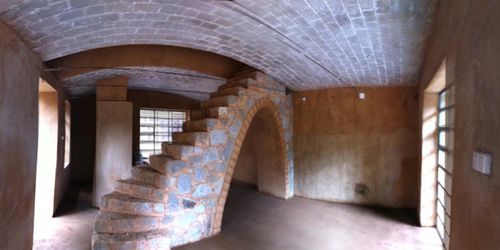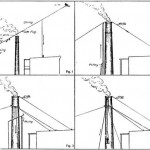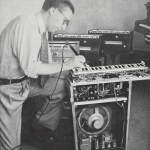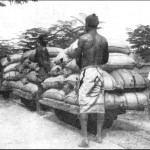The ‘Sustainable Urban Dwelling Unit’ (SUDU) in Ethiopia demonstrates that it is possible to construct multi-story buildings using only soil and stone. By combining timbrel vaults and compressed earth blocks, there is no need for steel, reinforced concrete or even wood to support floors, ceilings and roofs. The SUDU could be a game-changer for African cities, where population grows fast and building materials are scarce.
In “Tiles as a substitute for steel“, we highlighted the medieval art of the medieval timbrel vault, which allowed for structures that today no architect would dare to build without steel reinforcements. The technique is cheap, fast, ecological and durable. Shortly after the article was published in 2008, the timbrel vault made a comeback with two rather spectacular buildings: Richard Hawkes’ Crossway Passive House in England, and Peter Rich’s Mapungubwe Interpretation Centre in South Africa.
The cardboard formwork technique described last week promises to bring even more dramatic architecture, but at least as interesting is the news that the catalan vault is now also applied to a much more modest form of housing: the Sustainable Urban Dwelling Unit (SUDU), a low-cost family dwelling built in Ethiopia.
The Sustainable Urban Dwelling Unit (SUDU).
Though less spectacular at first sight, it could form the proof that even megacities can be constructed without the use of steel, concrete or wood. The double-story building, which was completed in last summer, is entirely made from soil and presents an economical and ecological solution to many of Africa’s most urgent problems. The SUDU stands in Addis Ababa, Ethiopia, a country with a population of more than 80 million (growing at an average 7 percent per year). The building is a joint project of the Swiss Federal Institute of Technology (ETH Zurich) and the Ethiopian Institute of Architecture, Building Construction and City Development (EiABC).
The SUDU combines past technologies from different continents, resulting in a new approach to low-tech construction adapted to specific local conditions. In the Mediterranean region, where the timbrel vault originated, the tiles have traditionally been made from fired clay. In the SUDU, the construction technique is united with the African tradition of cement-stabilized, soil-pressed bricks, which use locally available soil. This technique is called compressed earth block (CEB) construction. The SUDU has been built largely following the same techniques used for the Mapungubwe Centre in South Africa.
Urban housing
The SUDU was designed to achieve both environmental and economic sustainability. Because Ethiopia has few material and financial resources, the design is aimed at eliminating the reliance on imported, expensive and energy-intensive building materials such as steel and concrete. More unusual is that the building also excludes the use of wood, for the simple reason that wood is equally scarce in the country. The entire structure is made from locally available construction materials – and in the case of Ethiopia, these are very few: soil and stone.
The Sustainable Urban Dwelling Unit (SUDU).
One of the most challenging present problems for Africa (and throughout the developing world) is the tremendous deficit in housing for the urban poor. In Ethiopia, this is reflected in the ubiquitous informal housing, comprising perhaps 80% of the built environment of its capital, Addis Ababa. The most common vernacular construction method – construction with Eucalyptus wood and mud – is an economically and environmentally sustainable method of construction, but the problem of such constructions is that they are limited to one story – putting a huge strain on available land.
Thus, this vernacular technology has been more recently replaced by large urban housing projects of reinforced concrete, heavily subsidized by the government. These massive edifices of concrete and steel neither offer a model for frugal, environmentally or economically sustainable construction, nor do they offer a low-cost alternative to housing because they are too expensive to construct. The result is that more and more people are forced to be living on the streets. Whether it is the United States or Ethiopia, governments seem to prefer homeless people over shanty-towns.
The Sustainable Urban Dwelling Unit (SUDU).
In poorer areas of Addis Ababa, dwellings are often constructed from corrugated metal. These dwellings cannot be expanded upon for multi-story construction, yet sprawl outward, consuming limited resources including wood, expensive imported materials, and land.
Urban density
The SUDU is an exploration of a “medium ground” between single story informal dwelling and massive scale urban density, as studies have shown that even two-story buildings dramatically impact urban density. As the example of Tokyo shows, a megacity can be largely based on double-story buildings. Because the other aim is to build using only locally available materials, and wood reserves are scarce, the goals of SUDU were to build two stories in soil – a significant challenge without the aid of steel, concrete or milled lumber. Multiple-story soil architecture has a long tradition in Africa, though none of it has been constructed without wooden beams.
Building multiple stories in soil is a significant challenge without the aid of steel, concrete or lumber
As soil and stone have limited tensile capacity, building with these materials demands compression-only structural solutions. For walls carrying dominantly vertical loads, this criterium is easily satisfied. However, once a space must be spanned, beam elements – which work in bending – are typically required. A beam, as a structural system, demands that its section can accomodate tension and compression forces, which is not possible when building in stone or soil only.
The Sustainable Urban Dwelling Unit (SUDU) under construction.
By adapting local soil knowledge to the production of soil stablized tiles, however, it is possible to introduce the technology of timbrel vaulting to allow floor and roof systems of pure compression in multiple story buildings. Ethiopia has a rich soil, which contains high levels of clay particles. Almost all excavated material in the city of Addis Ababa is a possible source for the material needed to build new structures. The SUDU uses rammed earth techniques to construct the first level of the building, with a 60 cm wide wall structure. The ceilings and floors and the building are done using a tiled vauling technique using sun-dried tiles (first floor) and loam (for the roof) made from the very same soil.
Contrary to most other vaulting techniques, the catalan vault does require little to no formwork, again bypassing the need for wood.
Model for low-cost housing
Apart from the ecological and financial benefits, the construction technique used in the SUDU offers additional advantages. By drawing upon traditional methods, it engenders pride and social cohesion within the local community. And by using only locally available materials, it provides local jobs, introduces new skills and stimulates self-sufficiency. Through the economic benefits, the SUDU may become a model low-cost housing unit for the urban poor in Africa. It is meant to be a showcase to convince decision makers, economists, urban planners and architects to rethink traditional building methods and find new ways to build a town or even a city.
The construction of the SUDU was led by Lara Davis, who published a blog where the building process is documented from A to Z. There is also a movie. The BLOCK Research Group of the Swiss Federal Institute of Technology (ETH Zurich) has a webpage that links to all the research papers on the construction method. A book was presented November 25. Also of interest is a special architectural 2010 issue of the ADTF Journal published by the African Technology Development Forum. Several articles deal specifically with timbrel vaulting building methods, and outline some of the remaining challenges:
- “Tile vaulted systems for low-cost construction in Africa“.
- “Design and Construction of the Mapungubwe National Park Interpretive Centre, South Africa“.
Previously:
- Tiles as a substitute for steel: the art of the timbrel vault
- Timbrel vaulting in South Africa by Peter Rich
- Timbrel vaulting using cardboard formwork
- Engineering for the ecological age: lessons from history
- Building with mud and steel frames
- Building with pumice
- How to build a reciprocal roof frame
- How to build an earthbag dome
- How to build a medieval city
- Birch bark sauna
- Innovation and tradition: the complete works of Hassan Fathy online
- Why older buildings are more sustainable
- The solar envelope: how to heat and cool cities without fossil fuels






